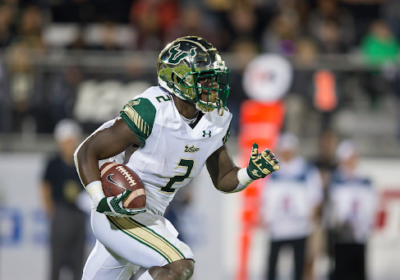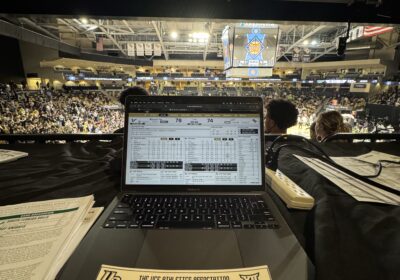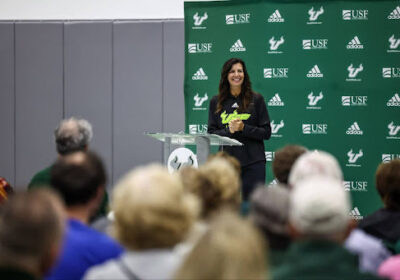Men’s soccer report card: Losing record overshadows pockets of hope

USF ended this season with more losses than wins as it faced top ranked schools and continued its losing streak against a familiar opponent.
The Bulls (6-9-1, 3-4-1 AAC) were able to catch its first win of the season in its fourth game against a non-conference team, Indiana.
USF battled Mercer in its first home game and lost 0-2. The Bulls ended its last game of the season at home against Memphis with a loss of 2-3.
Here’s an overview of South Florida’s season:
Game of the year
USF versus Indiana – Sept. 8
The USF men’s soccer team’s 1-0 victory over Indiana (12-4-4, 4-2-2 Big Ten) on Sept. 8 was impressive given the skill of its opponent. Indiana has 22 College cups and finished runner-up last season.
Anderson’s winning goal was not just a highlight of the game, but a showcase of USF’s ability to overcome high-ranked teams such as No. 22 Indiana.
This close match saw the Bulls take 11 shots over The Hoosiers’ 10.
Sophomore goalie Alan Horrocks had four crucial saves.
The Bulls effectively countered Indiana’s attacks and created opportunities for counter-strikes.
The match was a testament to the Bulls’ strategic gameplay, contributing to a memorable victory in front of a crowd of over 1,000 fans at Corbett Stadium.
The game against Indiana showed that USF could play well against tough teams.
Season heartbreak
USF versus Washington – Aug. 24
The opening loss against Washington (5-6-7, 2-4-4 Big Ten) 2-0 was more than just a tough start for the Bulls – it was a heartbreaker that continued a losing streak with the Huskies.
The Bulls, eager to overturn its two prior defeats against the Huskies, entered the game with determination.
Entering the season with strong preparation, the Bulls were met with a reality check. The offense struggled to penetrate Washington’s defense with only six shots.
The game against Washington highlighted the inconsistency with the Bull’s offense, emphasizing the need for a more reliable and impactful approach in its attacking game.
This loss set the tone for the season and put a damper on the enthusiasm for the Bulls’ opener.
The Huskies showed a bit more offensive prowess and took eight shots with three on target, keeping USF’s defense on its toes.
Both teams didn’t go down without a fight, as the physicality of the game was evident – the Bulls committed 11 fouls compared to Washington’s 18.
The defeat highlighted the team’s weakness and shaped USF’s strategy for future matches.
Season MVPs
Anderson and Afolabi lead the charge
Anderson stood out as the team’s top scorer and a pivotal figure in USF’s offense, with seven netted goals throughout the season.
His agility and knack for finding space in the box made him a consistent threat to opponents. Anderson’s ability to turn chances into goals was a highlight of the Bulls’ attacking play.
During the team’s 2-1 victory over Elon on Sept. 17, Anderson’s performance further solidified his role as the team’s top scorer and a key asset to USF’s offense.
“The coaches had talked to me about popping off the sandbox,” Anderson said. “It just happened where I popped off and [Spengler] gave [the ball] to me.”
Another key player, junior forward Segun Afolabi, made a significant impact with his dynamic play.
In USF’s match against Charlotte on Oct. 8, Afolabi made a crucial goal that demonstrated his ability to step up in important moments. But his contribution wasn’t just in scoring.
Afolabi’s assist record showed his versatility in linking up play, making him a valuable asset to the team.
Combining agility, precision and an eye for goals, Anderson and Afolabi formed an effective scoring duo for USF.
Bulls’ backline brilliance
This season saw the Bulls relying heavily on its defense – with mixed results.
The team often employed a formation, with a focus on building a solid defensive wall and relying on quick transitions to offense.
Horrocks was a consistent presence with 43 saves over the season. He only allowed 26 goals.
While primarily a defender, Schaefer played a dual role. He contributed offensively with two goals and six assists.
His versatility was a key aspect of the team’s strategy – though it also highlighted the need for a more focused defensive approach.
Despite the challenges faced throughout the season, Coach Bob Butehorn said he is confident in his team’s untapped potential.
“The path might be a little bit different but I still think there’s a good team there,” he said after USF’s 2-1 loss against Charlotte.
USF ended this season with 21 goals from 170 shots, highlighting its potential growth for next season.
Final grade: B-







